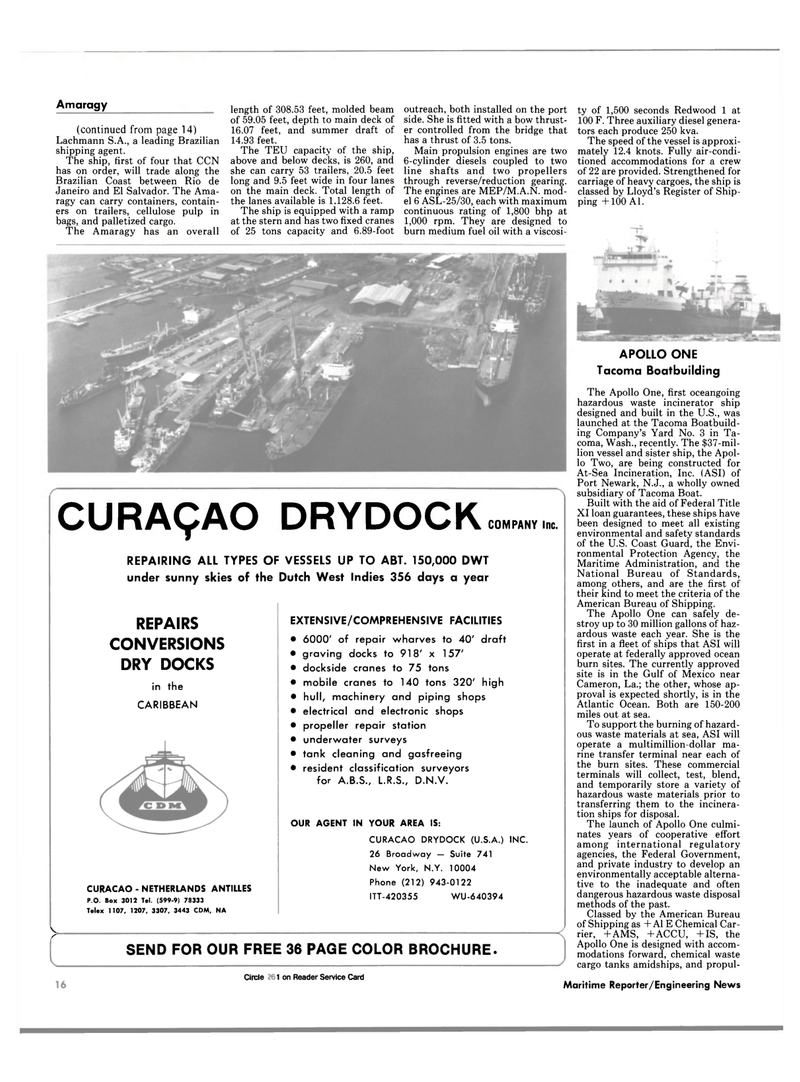
Page 14: of Maritime Reporter Magazine (December 1984)
Read this page in Pdf, Flash or Html5 edition of December 1984 Maritime Reporter Magazine
Amaragy (continued from page 14)
Lachmann S.A., a leading Brazilian shipping agent.
The ship, first of four that CCN has on order, will trade along the
Brazilian Coast between Rio de
Janeiro and El Salvador. The Ama- ragy can carry containers, contain- ers on trailers, cellulose pulp in bags, and palletized cargo.
The Amaragy has an overall length of 308.53 feet, molded beam of 59.05 feet, depth to main deck of 16.07 feet, and summer draft of 14.93 feet.
The TEU capacity of the ship, above and below decks, is 260, and she can carry 53 trailers, 20.5 feet long and 9.5 feet wide in four lanes on the main deck. Total length of the lanes available is 1.128.6 feet.
The ship is equipped with a ramp at the stern and has two fixed cranes of 25 tons capacity and 6.89-foot outreach, both installed on the port side. She is fitted with a bow thrust- er controlled from the bridge that has a thrust of 3.5 tons.
Main propulsion engines are two 6-cylinder diesels coupled to two line shafts and two propellers through reverse/reduction gearing.
The engines are MEP/M.A.N. mod- el 6 ASL-25/30, each with maximum continuous rating of 1,800 bhp at 1,000 rpm. They are designed to burn medium fuel oil with a viscosi-
CURASAO DRYDOCK
REPAIRING ALL TYPES OF VESSELS UP TO ABT. 150,000 DWT under sunny skies of the Dutch West Indies 356 days a year
COMPANY Inc.
REPAIRS
CONVERSIONS
DRY DOCKS in the
CARIBBEAN
CURACAO - NETHERLANDS ANTILLES
P.O. Box 3012 Tel. (599-9) 78333
Telex 1107, 1207, 3307, 3443 CDM, NA
EXTENSIVE/COMPREHENSIVE FACILITIES • 6000' of repair wharves to 40' draft • graving docks to 918' x 157' • dockside cranes to 75 tons • mobile cranes to 140 tons 320' high • hull, machinery and piping shops • electrical and electronic shops • propeller repair station • underwater surveys • tank cleaning and gasfreeing • resident classification surveyors for A.B.S., L.R.S., D.N.V.
OUR AGENT IN YOUR AREA IS:
CURACAO DRYDOCK (U.S.A.) INC. 26 Broadway — Sui te 741
New York, N.Y. 10004
Phone (212) 943-0122
ITT-420355 WU-640394 y
SEND FOR OUR FREE 36 PAGE COLOR BROCHURE. ty of 1,500 seconds Redwood 1 at 100 F. Three auxiliary diesel genera- tors each produce 250 kva.
The speed of the vessel is approxi- mately 12.4 knots. Fully air-condi- tioned accommodations for a crew of 22 are provided. Strengthened for carriage of heavy cargoes, the ship is classed by Lloyd's Register of Ship- ping + 100 Al.
APOLLO ONE
Tacoma Boatbuilding
The Apollo One, first oceangoing hazardous waste incinerator ship designed and built in the U.S., was launched at the Tacoma Boatbuild- ing Company's Yard No. 3 in Ta- coma, Wash., recently. The $37-mil- lion vessel and sister ship, the Apol- lo Two, are being constructed for
At-Sea Incineration, Inc. (ASI) of
Port Newark, N.J., a wholly owned subsidiary of Tacoma Boat.
Built with the aid of Federal Title
XI loan guarantees, these ships have been designed to meet all existing environmental and safety standards of the U.S. Coast Guard, the Envi- ronmental Protection Agency, the
Maritime Administration, and the
National Bureau of Standards, among others, and are the first of their kind to meet the criteria of the
American Bureau of Shipping.
The Apollo One can safely de- stroy up to 30 million gallons of haz- ardous waste each year. She is the first in a fleet of ships that ASI will operate at federally approved ocean burn sites. The currently approved site is in the Gulf of Mexico near
Cameron, La.; the other, whose ap- proval is expected shortly, is in the
Atlantic Ocean. Both are 150-200 miles out at sea.
To support the burning of hazard- ous waste materials at sea, ASI will operate a multimillion-dollar ma- rine transfer terminal near each of the burn sites. These commercial terminals will collect, test, blend, and temporarily store a variety of hazardous waste materials prior to transferring them to the incinera- tion ships for disposal.
The launch of Apollo One culmi- nates years of cooperative effort among international regulatory agencies, the Federal Government, and private industry to develop an environmentally acceptable alterna- tive to the inadequate and often dangerous hazardous waste disposal methods of the past.
Classed by the American Bureau of Shipping as + Al E Chemical Car- rier, + AMS, +ACCU, +IS, the
Apollo One is designed with accom- modations forward, chemical waste cargo tanks amidships, and propul- 36 Circle 134 on Reader Service Card Maritime Reporter/Engineering News

 13
13

 15
15
